
| Joint Institute for Nuclear Research Museum of History of Science and Technology of JINR |
| |||||||||||||||||||||||||||||||||||||||

Zlotnikova Anastasiya |
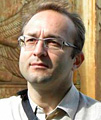
Dryablov Dmitry |
|
e-mail: popular@jinr.ru https://www.facebook.com/lectorij.nauka.dubna tel.: 8(916)874-62-86, 8(903)007-98-41 |
|
Physics of fundamental particles of matter - Bird's Eye View | |
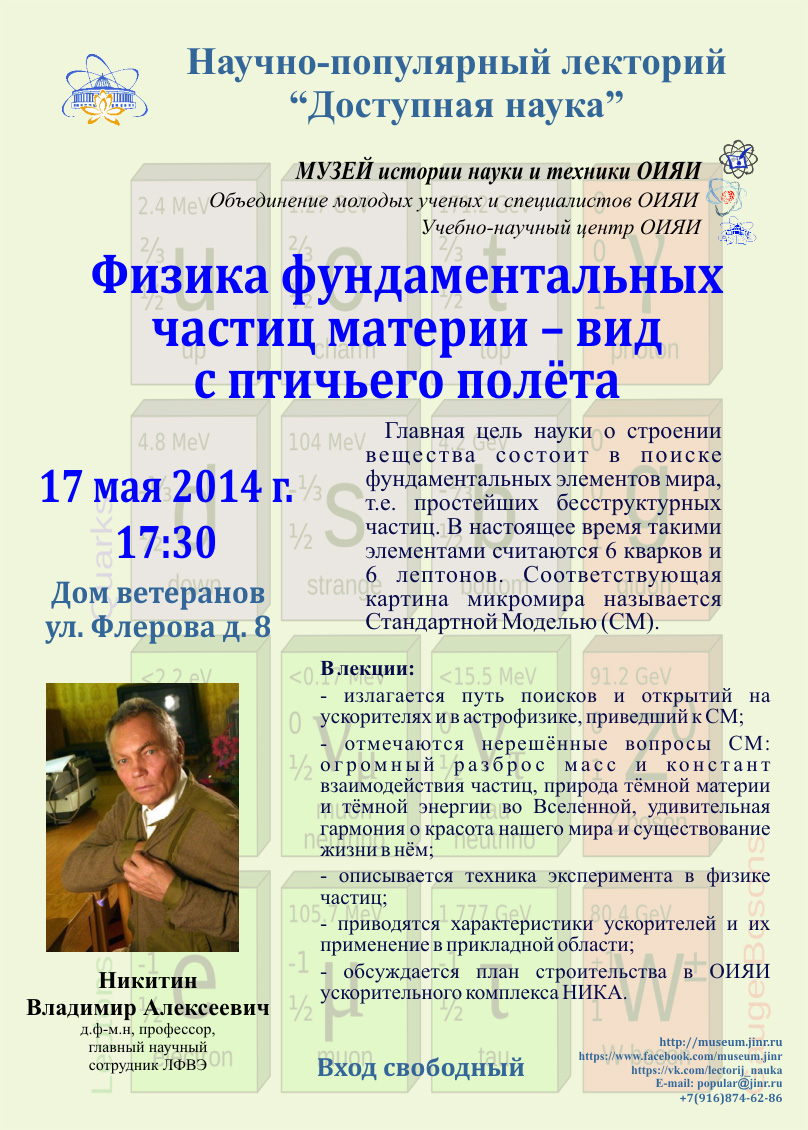 |
May 17, 2014. Speaker: V.A. Nikitin, Doctor of Sciences, Professor, Chief researcher VBLHEP JINR The lecturer acted with his stylistically brilliant and richly illustrated lecture, in which he expressed the evolution of human representation of the elements of matter, described the instruments and methods of study of elementary structure of matter and offered his vision of tasks and the role of science. V.A. Nikitin told about characteristics of accelerators and their application, raised the issue of construction of a new accelerator complex NICA in JINR. At the lecture was attended by about 30 participants, among whom there were both scientists and specialists of JINR, students and interested citizens. The lecture far exceeded the scope of the originally planned one and a half hours and has initiated a number of questions. Content of the report can be viewed at this link. |
Quarks and the secrets of the structure of matter | |
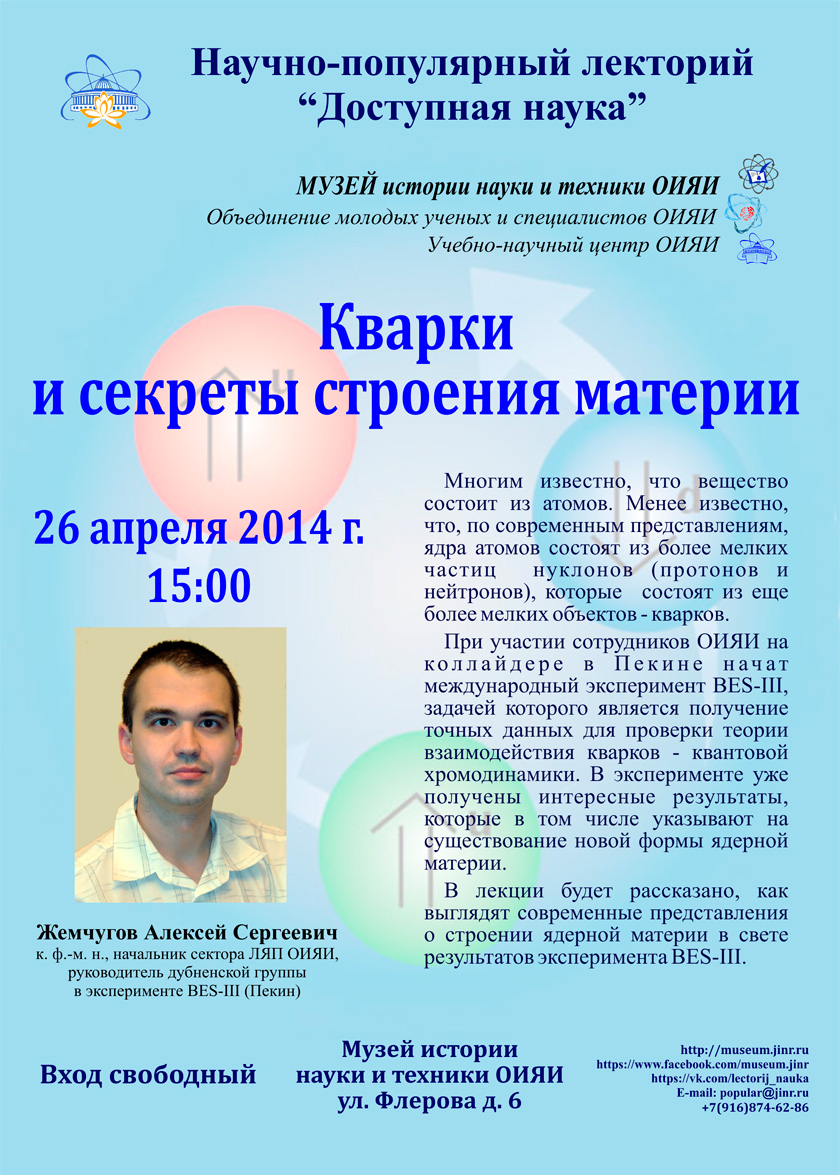 |
Speaker: A.S. Zhemchugov, Candidate of Science (Phys. and Math.), Head of the LNP, the head of Dubna group in the experiment BES-III. A brief summary of the lecture: Many known that the substance is composed of atoms. Less well known is that, according to modern concepts, the nuclei of atoms consist of smaller particles - the nucleons (protons and neutrons), which consist of even smaller objects - quarks. With the participation of JINR staff collider in Beijing launched an international experiment BES-III, whose task is to provide accurate data to test the theory of interaction between quarks - quantum chromodynamics. The experiment has already produced interesting results, including that indicate the existence of a new form of nuclear matter. The lecture was on how to look modern ideas about the structure of nuclear matter in the light of the results of the experiment BES-III. Content of the report can be viewed at this link. Some pictures from the lecture can be found in the "Photo Gallery". |
Modern cosmology | |
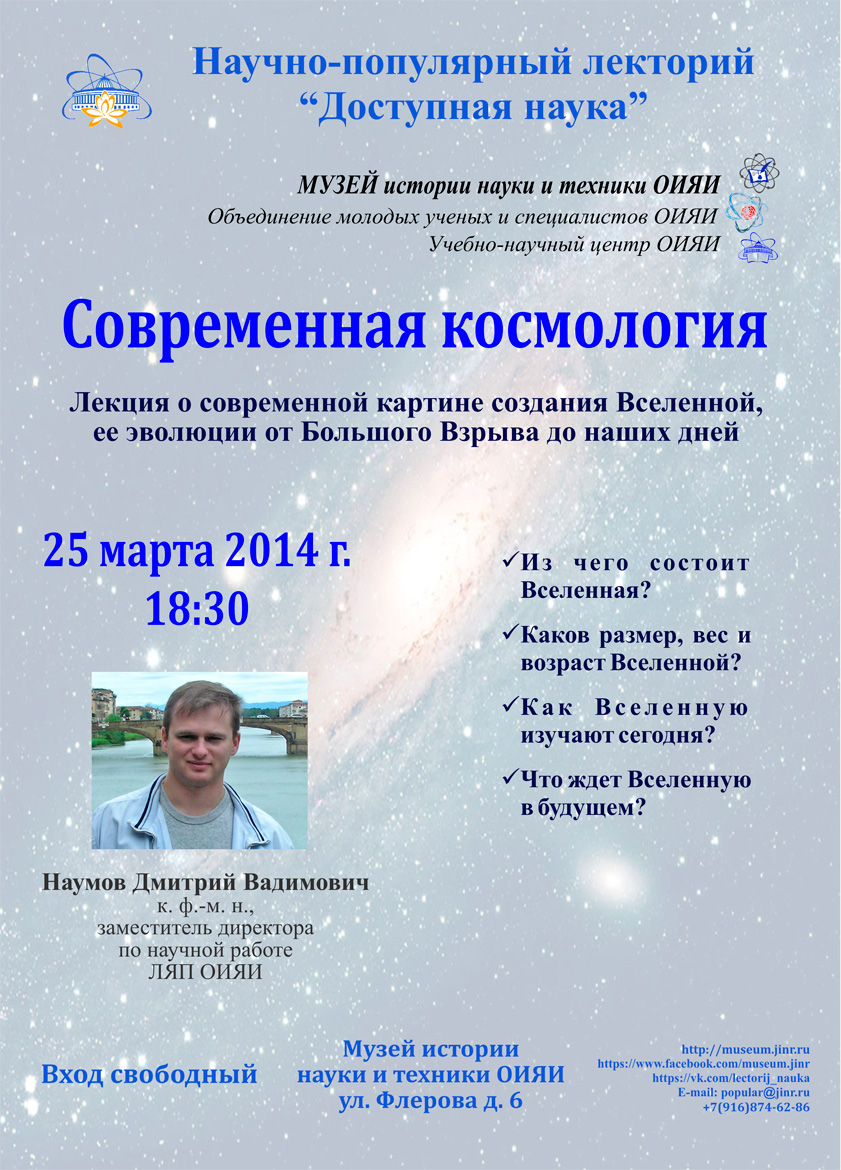 |
March 25, 2014. Speaker: D. Naumov, Candidate of Science (Phys. and Math.), Deputy director for scientific work LNP Lecture on cosmology caused extraordinary interest among residents. This day the museum attracted a record number of participants - 87 people. Lecture hall with great difficulty managed to accommodate the number of interested persons, among whom there were students (starting with elementary grades), students, young and not-so scientists and specialists, as well as all those who were interested in the subject. The participants listened with great interest to the lecturer who excitingly and accessibly told about the creation of the modern picture of the Universe, its evolution from the Big Bang to the present day. What is in the universe, what is its size, weight and age, as her study today that awaits us in the future - the answers to these and other questions lecturer presented in his report. Content of the report can be viewed at this link: Content of the report can be viewed at this link. Some pictures from the lecture can be found in the "Photo Gallery". |
Neutron detectors of explosives and drugs | |
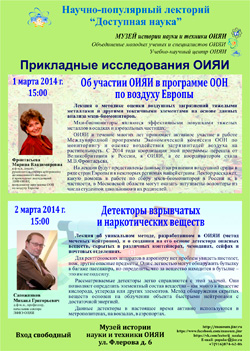 |
March 2, 2014. Speaker: M.G.Sapozhnikov, Doctor of Science, chief of sector in VBLHEP JINR, project manager of DVIN. The lecturer told about the unique method of detection using neutron detector of explosives and drugs in different containers, suitcases, safes and mailings. For x-ray devices at the airport there are no problems to see the gun, a knife, other dangerous subjects. They can easily find a bottle in passenger baggage, but to define what the substance is in the bottle - it's unaffordable. These detectors allow us to determine the elemental composition of matter. Radiation of the hidden substances by fast neutrons with sufficient energy defines the maintenance of capacities. These detectors are widely used now in subways, at train stations, at the airports. M.G.Sapozhnikov spoke about other areas of use of detectors - such as the development of diamond deposits. Students (it were generally young scientists) asked a lot of questions to the lecturer, and he invited them to cooperate. Content of the report can be viewed at this link. Some pictures from the lecture can be found in the "Photo Gallery". |
About the participation of JINR in the UN program of Europe air | |
 |
March 1, 2014. Lecturer: M.V. Frontasyeva, the Associate Professor, the head of sector of the neutron activation analysis and applied researches of Frank Laboratory of Neutron Physics, JINR, coordinator (from 2014 ) of the International Programme on the air in Europe. The lecture was devoted to methods of assessment of air pollution with heavy metals and other toxic elements from the data analysis of moss bio-monitors. People gathered in the museum were of different generations, schoolchildren, students and teachers, physicists from JINR. For most present a great discovery was the fact that mosses are effective traps metals in sediments and aerosol particles. The lecturer spoke about her work in the International Programme monitoring and evaluating the impact of air pollutants on vegetation UN European Economic Commission. She presented the data on the environmental situation in several European countries and in some regions of our country, including Dubna. Lecturer told what kind of assistance in the collection of mosses can be provided. It is encouraging that some listeners, including those from Armenia and Belarus expressed their willingness to provide all possible support to these initiatives. Content of the report can be viewed at this link. Some pictures from the lecture can be found in the "Photo Gallery". |
And yet it moves | |
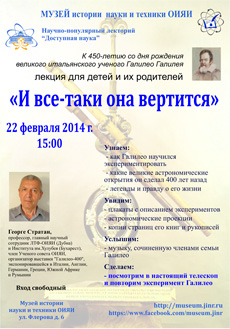 |
February 22, 2014. Speaker: George Stratan, Professor, Chief Researcher LTP JINR (Dubna) and the National Institute of Nuclear Physics and Technology H.Hulubeya (Bucharest), a member of the Scientific Council, organizer of " Galileo-400", exhibited in Germany, England, Italy , Greece, South Africa and Romania, as well as the Moscow Planetarium. Part of the exhibition was represented in the museum. The lecture was devoted to the life and work of the great Italian scientist Galileo Galilei. The lecture was attended by children aged 7 to 13 years, as well as their parents and grandparents - in total more than 40 people. The lecturer talked about very exciting astronomical discoveries made by Galileo, about little-known facts of his biography, about the myths and legends associated with his name. Professor talked with the children on equal terms, as well as with his colleagues - to make guys feel completely immersed in the atmosphere of real scientific discussion. In simple examples children and adults learned how Galileo counted increasing strength of his telescopes. Children looked at the telescope and repeated the experiment of Galileo. Some pictures from the lecture can be found in the "Photo Gallery". |
|
| |
Megascience and High Energy Physics | |
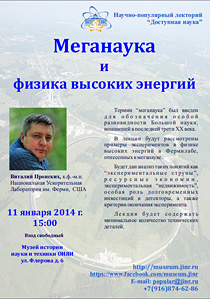 |
January 11, 2014. Speaker: Vitaly Pronskih, an employee of Fermi National Accelerator Laboratory (U.S.А.). Lecturer told about the organization of scientific research on accelerators and gave examples of experiments at Fermilab. The lectures were attended by 35 Dubna residents, of different ages, roughly half of whom were staff members of JINR. Many of those present (scientists and science have no relationship) very positively spoke about the lecture and expressed a desire to come to the next. Lecturer himself noted "good, attentive and patient audience" that had gathered that day at the museum. Some pictures from the lecture can be found in the "Photo Gallery". |
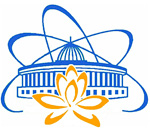 Popular scientific lectures "Available Science"
Popular scientific lectures "Available Science"